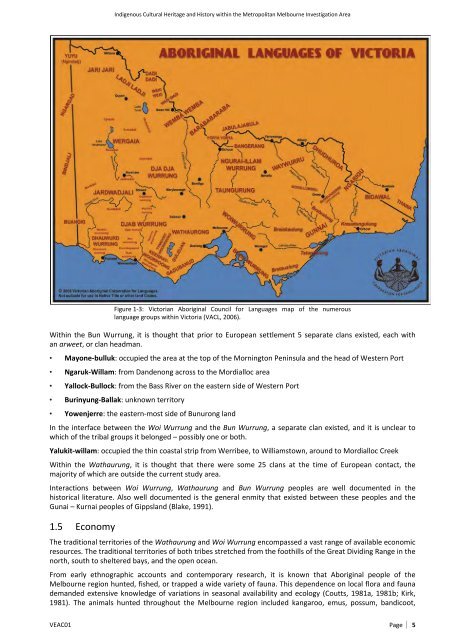Indigenous Cultural Heritage and History within the Metropolitan ...
Indigenous Cultural Heritage and History within the Metropolitan ...
Indigenous Cultural Heritage and History within the Metropolitan ...
You also want an ePaper? Increase the reach of your titles
YUMPU automatically turns print PDFs into web optimized ePapers that Google loves.
<strong>Indigenous</strong> <strong>Cultural</strong> <strong>Heritage</strong> <strong>and</strong> <strong>History</strong> <strong>within</strong> <strong>the</strong> <strong>Metropolitan</strong> Melbourne Investigation Area<br />
Figure 1‐3: Victorian Aboriginal Council for Languages map of <strong>the</strong> numerous<br />
language groups <strong>within</strong> Victoria (VACL, 2006).<br />
Within <strong>the</strong> Bun Wurrung, it is thought that prior to European settlement 5 separate clans existed, each with<br />
an arweet, or clan headman.<br />
• Mayone‐bulluk: occupied <strong>the</strong> area at <strong>the</strong> top of <strong>the</strong> Mornington Peninsula <strong>and</strong> <strong>the</strong> head of Western Port<br />
• Ngaruk‐Willam: from D<strong>and</strong>enong across to <strong>the</strong> Mordialloc area<br />
• Yallock‐Bullock: from <strong>the</strong> Bass River on <strong>the</strong> eastern side of Western Port<br />
• Burinyung‐Ballak: unknown territory<br />
• Yowenjerre: <strong>the</strong> eastern‐most side of Bunurong l<strong>and</strong><br />
In <strong>the</strong> interface between <strong>the</strong> Woi Wurrung <strong>and</strong> <strong>the</strong> Bun Wurrung, a separate clan existed, <strong>and</strong> it is unclear to<br />
which of <strong>the</strong> tribal groups it belonged – possibly one or both.<br />
Yalukit‐willam: occupied <strong>the</strong> thin coastal strip from Werribee, to Williamstown, around to Mordialloc Creek<br />
Within <strong>the</strong> Wathaurung, it is thought that <strong>the</strong>re were some 25 clans at <strong>the</strong> time of European contact, <strong>the</strong><br />
majority of which are outside <strong>the</strong> current study area.<br />
Interactions between Woi Wurrung, Wathaurung <strong>and</strong> Bun Wurrung peoples are well documented in <strong>the</strong><br />
historical literature. Also well documented is <strong>the</strong> general enmity that existed between <strong>the</strong>se peoples <strong>and</strong> <strong>the</strong><br />
Gunai – Kurnai peoples of Gippsl<strong>and</strong> (Blake, 1991).<br />
1.5 Economy<br />
The traditional territories of <strong>the</strong> Wathaurung <strong>and</strong> Woi Wurrung encompassed a vast range of available economic<br />
resources. The traditional territories of both tribes stretched from <strong>the</strong> foothills of <strong>the</strong> Great Dividing Range in <strong>the</strong><br />
north, south to sheltered bays, <strong>and</strong> <strong>the</strong> open ocean.<br />
From early ethnographic accounts <strong>and</strong> contemporary research, it is known that Aboriginal people of <strong>the</strong><br />
Melbourne region hunted, fished, or trapped a wide variety of fauna. This dependence on local flora <strong>and</strong> fauna<br />
dem<strong>and</strong>ed extensive knowledge of variations in seasonal availability <strong>and</strong> ecology (Coutts, 1981a, 1981b; Kirk,<br />
1981). The animals hunted throughout <strong>the</strong> Melbourne region included kangaroo, emus, possum, b<strong>and</strong>icoot,<br />
VEAC01<br />
Page | 5
















